Ash1, a daughter cell-specific protein, is required for pseudohyphal growth of Saccharomyces cerevisiae
- PMID: 9566907
- PMCID: PMC110667
- DOI: 10.1128/MCB.18.5.2884
Ash1, a daughter cell-specific protein, is required for pseudohyphal growth of Saccharomyces cerevisiae
Abstract
Ash1 (for asymmetric synthesis of HO) was first uncovered in genetic screens that revealed its role in mating-type switching. Ash1 prevents HO expression in daughter cells. Because Ash1 has a zinc finger-like domain related to that of the GATA family of transcription factors, it presumably acts by repressing HO transcription. Nonswitching diploid cells also express Ash1, suggesting it could have functions in addition to regulation of HO expression. We show here that Ash1 has an essential function for pseudohyphal growth. Our epistasis analyses are consistent with the deduction that Ash1 acts separately from the mitogen-activated protein kinase cascade and Ste12. Similarly to the case in yeast form cells, Ash1 is asymmetrically localized to the nuclei of daughter cells during pseudohyphal growth. This asymmetric localization reveals that there is a previously unsuspected daughter cell-specific function necessary for pseudohyphal growth.
Figures

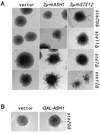
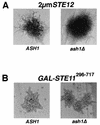
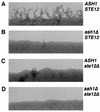
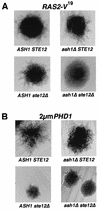

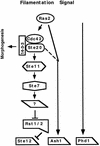
References
-
- Becker D M, Guarente L. High efficiency transformation of yeast by electroporation. Methods Enzymol. 1990;194:182–187. - PubMed
-
- Bobola N, Jansen R-P, Shin T H, Nasmyth K. Asymmetric accumulation of Ash1p in postanaphase nuclei depends on a myosin and restricts yeast mating-type switching to mother cells. Cell. 1996;84:699–709. - PubMed
Publication types
MeSH terms
Substances
Grants and funding
LinkOut - more resources
Full Text Sources
Molecular Biology Databases
